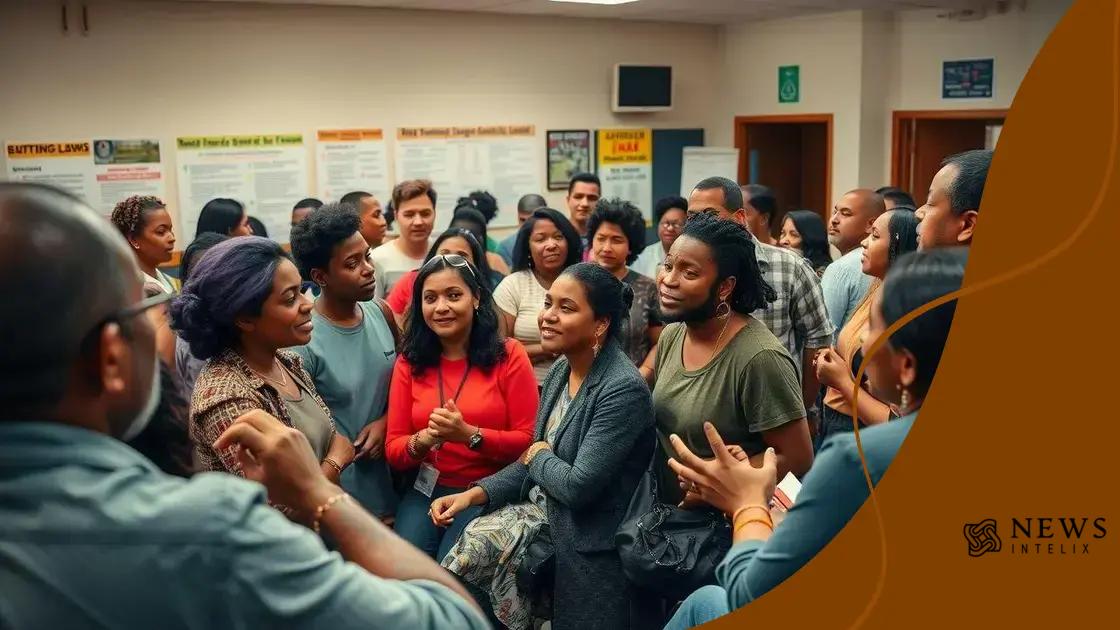Border policy sees bipartisan revision in focus

Bipartisan immigration reform focuses on collaborative efforts between political parties to create fair and effective immigration policies that balance national security with compassion for immigrants.
Border policy sees bipartisan revision as lawmakers on both sides come together to address pressing issues. This shift indicates a potential reevaluation of immigration systems and their impact. Curious about how these changes might affect you? Let’s dive in.
Understanding the current state of border policy
Understanding the current state of border policy is crucial as it affects many aspects of immigration. This topic brings in legal, social, and economic implications that are significant.
Recent Developments in Border Policy
Over the last few years, various changes have been implemented to address challenges at the border. These changes were designed to ensure safety and streamline processes.
- Increased border security measures
- Policy revisions impacting asylum seekers
- Adjustments to visa processes
In addition to these measures, lawmakers are now focused on finding common ground. The bipartisan effort emphasizes the need for a fair system that addresses concerns from both sides of the aisle.
Impact on Daily Life
The current state of border policy affects many Americans and immigrants alike. For example, families often face uncertainty due to changes in immigration status and regulations. Many individuals seeking a better life in the U.S. find the regulations daunting.
Moreover, local economies can feel the effects of shifting policies. Businesses that rely on immigrant labor may face challenges, underscoring the importance of stable and predictable border regulations.
Ongoing Discussions
The dialogue surrounding border policy remains active. Community forums and town halls provide spaces for discussion on these topics. It is essential for citizens to engage in these conversations, voicing their concerns and suggestions.
- Encouraging civic engagement
- Promoting awareness of new regulations
- Advocating for humane treatment of immigrants
Key players in bipartisan discussions
In the realm of bipartisan discussions, several key players play an important role in shaping border policy. Their influence on negotiations makes understanding their positions critical.
Political Leaders
Famous political leaders from both parties come together to address challenges concerning immigration. They bring different perspectives and strategies that affect policymaking. Leaders work to find common ground, which is vital in reaching compromises.
- Senators advocating for stricter security
- Representatives pushing for immigration reform
- Congressional committees reviewing existing policies
These leaders often engage in open discussions to voice their viewpoints. This dynamic creates an environment that encourages collaboration.
Advocacy Groups
Advocacy groups also play a significant role in these discussions. They represent various constituencies and help amplify the voices of those affected by border policies. These organizations focus on ensuring that immigrant rights are protected while urging for sensible policies.
- Nonprofit organizations supporting immigrants
- Community groups highlighting local concerns
- Think tanks analyzing policy impacts
Through sustained efforts, advocacy groups drive important conversations. Their input can influence legislative changes that address community needs.
Public Opinion
Another vital aspect of bipartisan discussions is public opinion. Citizens often share their views through social media and community forums, placing pressure on decision-makers. Understanding what constituents care about helps leaders prioritize issues during negotiations.
Engagement from the public allows for a richer dialogue on border policy. Bringing various voices to the table creates an environment where diverse ideas can flourish, leading to robust solutions.
Recent changes to immigration laws

Recent changes to immigration laws have sparked significant discussion among lawmakers and citizens alike. These modifications reflect ongoing efforts to address the complex landscape of immigration policy.
Key Legislative Updates
In the past year, several important updates have been introduced. These changes aim to enhance security measures while also supporting those seeking refuge in the country. The balance of enforcing laws and providing shelter is a focal point for lawmakers as they draft new policies.
- Adjustment of asylum procedures to streamline applications
- Expansion of visa categories for skilled workers
- Increased funding for border security initiatives
Ensuring fair treatment while maintaining safety remains a priority. Each legislative update carries implications that resonate beyond the walls of Congress.
Impact on Communities
The recent changes affect communities across the nation. Local governments and organizations are adapting to new regulations. Many communities are rallying to support both immigrants and long-standing residents as they navigate these updates.
Local businesses also feel the effects of immigration law changes. For instance, workforce availability can fluctuate due to new visa restrictions. Communities must be prepared to advocate for policies that support both the economy and immigrant rights.
Public Response
Public reaction to these immigration law changes has been mixed. Many advocate for robust reform, while others express concerns over the potential consequences of new policies. Understanding the variety of opinions is crucial for moving forward.
- Citizens rallying for more humane policies
- Community meetings addressing concerns and fears
- Advocacy groups mobilizing to influence changes
Engaging the public in this dialogue is vital as it shapes further discussions on immigration reform. Stakeholders are encouraged to stay informed and active in these conversations.
Impact of border policy on communities
The impact of border policy on communities is significant and multifaceted. Each decision made at the national level can resonate deeply within local neighborhoods, shaping daily life for many.
Economic Effects
One of the most noticeable impacts is economic. Changes in border policy can affect job availability and local businesses. When policies become stricter, businesses that rely on immigrant labor may struggle.
- Potential job shortages in certain sectors
- Changes in consumer spending habits
- Economic instability in immigrant communities
When workers face uncertainty, the economy suffers. Forecasting the effects of these changes helps communities prepare for potential downturns.
Social Dynamics
Furthermore, the social fabric of communities can be affected. For many immigrants, changes in policies lead to anxiety and fear. Families may feel they are living under constant threat, which alters how communities interact.
Local outreach programs are crucial for supporting individuals impacted by these policies. They help address the social challenges that arise when families have to navigate a confusing and oftentimes hostile environment.
Community Responses
Communities respond in varied ways to the challenges posed by border policy. Some localities may strengthen their support networks, providing resources and safety nets for affected families.
- Formation of support groups for immigrant families
- Increased advocacy for humane policies
- Community events aimed at bridging gaps and fostering understanding
This grassroots response can empower residents to advocate for change at higher levels, amplifying their voices.
Future prospects for bipartisan immigration reform
The future prospects for bipartisan immigration reform appear to be a mix of hope and challenges. As lawmakers reflect on the current state of policies, the potential for meaningful change remains a hot topic.
Emerging Collaborative Efforts
In recent months, there has been a push for collaboration between both political parties. Lawmakers are recognizing the need for a comprehensive approach that addresses the complexities of immigration.
- Joint committees focused on reform initiatives
- Increased dialogue between party leaders
- Community input driving proposed changes
This collaboration may pave the way for laws that better reflect the needs of all Americans while ensuring humane treatment of immigrants.
Public Opinion Influence
Public sentiment is becoming increasingly important in shaping immigration reform. Citizens are speaking up about their experiences and expectations regarding future policies. With advocacy groups gaining momentum, their voices play a significant role.
Engagement in community discussions and forums is crucial. These interactions allow constituents to express their concerns and desires, highlighting the real-world implications of immigration laws.
Challenges Ahead
Despite the positive signs, several challenges persist. Polarization in politics often hinders progress on important issues like immigration reform. The differing opinions on how to handle these matters can lead to stalemates.
- Resistance to change within party lines
- Lack of unified strategies for reform
- Concerns over implementation and enforcement
Overcoming these hurdles requires a commitment from all stakeholders. Solutions will depend on the willingness to engage in constructive dialogue and seek common ground.
FAQ – Questions about Bipartisan Immigration Reform
What is bipartisan immigration reform?
Bipartisan immigration reform refers to collaborative efforts between political parties to create fair and effective immigration policies.
Why is public opinion important in shaping immigration policy?
Public opinion influences lawmakers by highlighting community needs and concerns, prompting them to consider the impact of policies on real lives.
What challenges do lawmakers face when discussing immigration reform?
Lawmakers often encounter political polarization, differing opinions, and resistance to change, which can hinder progress.
How can communities engage in the immigration reform process?
Communities can engage by participating in town halls, advocating for policies, and sharing their experiences to inform lawmakers.
